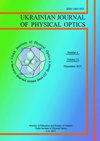Bi12SiO20晶体光吸收的热激活光谱
IF 8.6
4区 物理与天体物理
0 OPTICS
引用次数: 3
摘要
我们建议应用热激活光谱法来研究杂质的光学吸收问题。该方法包括测量宽间隙半导体晶体中光吸收的温度依赖性,并分析这种依赖性的温度导数。上述技术可以确定杂质中心的热活化和光活化的能量以及电子-声子相互作用的强度。本文章由计算机程序翻译,如有差异,请以英文原文为准。
Thermally activated spectroscopy of optical absorption in Bi12SiO20 crystals
We suggest applying a method of thermally activated spectroscopy to the problem of impurity optical absorption. The method consists in measuring the temperature dependence of optical absorption in a wide-gap semiconductor crystal and analyzing the temperature derivative of this dependence. The above technique allows for determining the energies of thermal and optical activations and the strength of electron–phonon interaction for the impurity centres.
求助全文
通过发布文献求助,成功后即可免费获取论文全文。
去求助
来源期刊
CiteScore
9.90
自引率
0.00%
发文量
20
审稿时长
>12 weeks
期刊介绍:
“Ukrainian Journal of Physical Optics” contains original and review articles in the fields of crystal optics, piezo-, electro-, magneto- and acoustooptics, optical properties of solids and liquids in the course of phase transitions, nonlinear optics, holography, singular optics, laser physics, spectroscopy, biooptics, physical principles of operation of optoelectronic devices and systems, which need rapid publication.
The journal was founded in 2000 by the Institute of Physical Optics of the Ministry of Education and Science of Ukraine.

 求助内容:
求助内容: 应助结果提醒方式:
应助结果提醒方式:


